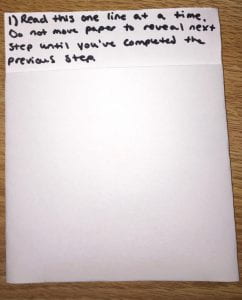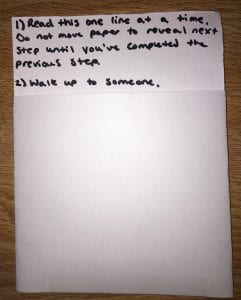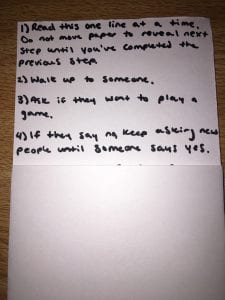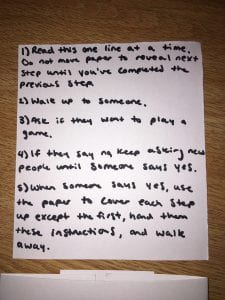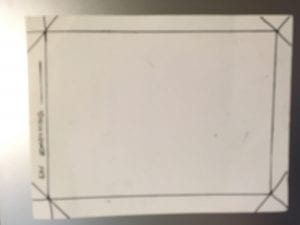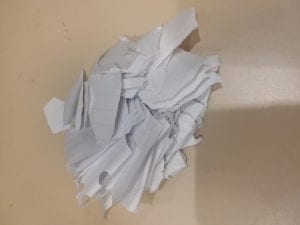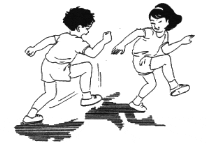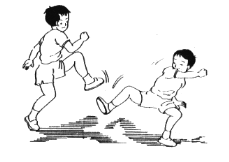Score:
Let an hourglass run for a minute or two.
Three people are doing their own thing.
The two become the painting and one becomes the painter.
The two don’t move by themselves as the hourglass flows.
Only the painter can move them.
Before the hourglass is up, he must return to his original position.
The hourglass goes.
The living are no longer the painting.
Work’s Intention
My intention with this wasn’t too complicated.As a child, I had always dreamed of being able to freeze time, and so this is basically bringing that into a game-like setting. My goal is, for a minute or two, let that child within someone to run out and play around and mess up the world. Imagine you were told that you could stop what everyone was doing, and then mess with it. Make your own creation. That is why I named it as so– a living painting. A painting is a representation of what you want on paper, and so I took that idea and placed it in reality, but mixed it with my old childhood fantasy. It is a simple game that has no real depth or intention, but just some fun. It is also very interesting to see what people are willing to do and what ideas they get when they are given complete freedom to screw with the “world” as they see fit. Like a child’s playground with living people. Well, when it’s put like that, it sounds kind of morbid, but I believe it gets the point across. Another major part is that, like every child’s fantasy (and especially a child’s imagination as he grows older), it comes to an end for the most part, which is why the people are able to move after because the “painting” moment is over. I still kind of wish I was able to do this because it would be a pretty overpowered ability to have.This specific iteration of the piece went through a bunch of different versions. The other ones were a lot more complicated, so I made this one a lot simpler.
Work’s Influence
Like mentioned before, a major influence was the dream of freezing time and doing what you want while time is frozen. This pseudo-version of that is as close as we can get to something similar to freezing time. But another influence would be my background in psychology and sociology. I always want to know how people will react and what interesting things they can come up with when given free rein. As I am a very awkward child who is not well versed in the idea of common sense, I am still ways off from predicting this sort of this, so it brings laughs as well. One of Yoko Ono’s pieces that inspired this one was the baby carriage, mostly because of how people would react to an empty carriage. It seems really funny, to do what you want, like driving an empty baby carriage around, and see the weird looks on people’s faces and how strangely (or not) on how they react to you.
The Painting
I actually found very interesting what my friend Ben did as the painter. For this score, I enlisted the help of my three roommates. Ben was the painter, and Cam and Ryan were part of the painting. He first started to mess with Cam, then moved to Ryan, then almost went back to Cam when he thought of something. Something that I probably would have never done or figured out. Unfortunately, it is rather explicit and inappropriate, so I can’t say it outright, but he placed a tissue full of lotion in Ryan’s hand and drew a pic of a nude woman and put it in front of Ryan. A very “interesting,” if I might say, approach to the game. I did not think it would go that way, but it did. Very cool how the game went a whole different path from what I initially intended.
CAUTION!! A slightly offensive and inappropriate drawn image may appear at end of video. User Discretion is advised.
https://drive.google.com/open?id=0B7dmQkZFrzNEdVU2elZrR2VNN1E

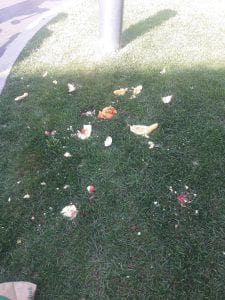
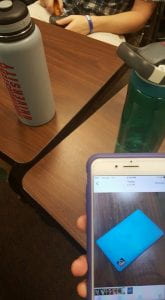 First picture taken in the score today
First picture taken in the score today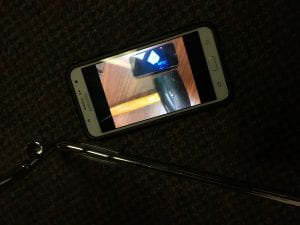 The final picture of the score from today’s class
The final picture of the score from today’s class